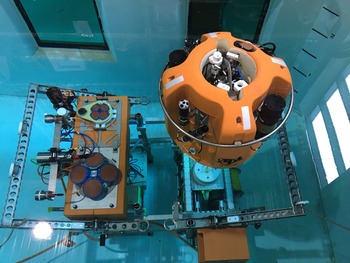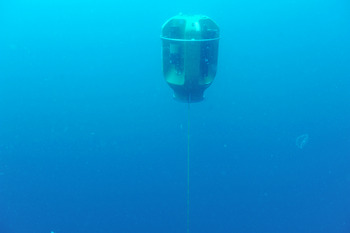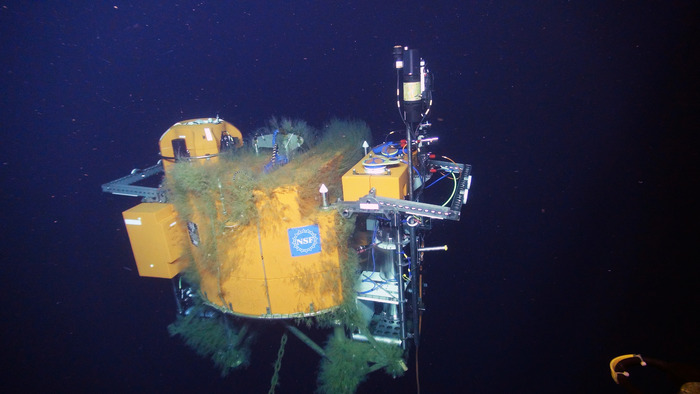
A Shallow Profiler winched science pod and stationary platform, which host 18 instruments (e.g. pH, CO2, temperature, chlorophyll, zooplankton, nutrients, currents) undergoes testing in the School of Oceanography saltwater tank. The platforms will be deployed 600 ft beneath the oceans surface. Since 2015, three of these pods have made >27,000 profiles, providing unprecedented measurements of our dynamic ocean in real-time. Credit: D. Kelley, University of Washington.

The Winched Shallow Profiler engulfed in soft sunlight rises up 30 m beneath the ocean's surface. Located at the Slope Base site it is measuring nutrients, dissolved oxygen and carbon dioxide concentrations, seawater acidity, temperature and chlorophyll concentrations at high temporal and spatial resolution, controlled from >200 miles onshore through the Internet at the University of Washington. Credit: NSF-OOI/UW/ISS; V15.
The University of Washington Applied Physics Laboratory designed and installed state-of-the-art Shallow Profiler Moorings unlike any now in the worlds' oceans to meet the science requirements for the Cabled Array component of the National Science Foundation’s Ocean Observatories Initiative (OOI). The moorings are some of the most technologically advanced in the worlds’ oceans: since 2015, the cabled science pods have completed >27,000 profiles making detailed time-series measurements of ocean properties never before possible.
The two-legged Shallow Profiler Moorings are installed at the cabled Slope Base (2900 m), Oregon Offshore (600 m), and Axial Base (2700 m) sites. Data from 18 instruments on each mooring have been sent live to shore since late Summer, 2015 when the science components were replaced as part of the schedule Operations and Maintenance VISIONS’15 cruise. Each mooring hosts a 7,000 lb, 12 ft-across platform 200 m beneath the oceans’ surface. The moorings are connected to the Cabled Array high power and bandwidth fiber optic cables, which provide live interactive command and control capabilities from the University of Washington Operations Center and real-time data flow (engineering and science) into the OOI Data Portal.
Each 12 foot across platform hosts a stationary, instrumented Platform Interface Assembly and a winched Science Pod. A significant technological challenge for the winched Science Pods was that they required a long-lived, underwater optical slip ring on the turning winch for live communications-data transmission, as well as a rugged, controllable underwater level wind to let the cabled, buoyant Science Pod rise and descend in the water column. When weather is bad and sea states are high, smart controllers built into the system keep the profiler pods deeper beneath the surface. Missions for the profilers include 9 trips/day through the water column and automated step functions to stop the profiler pod at specific depths and turning of instruments on and off that require stationary measurements (e.g. CO2).
Instruments on the stationary platform assembly at Slope and Axial Base include pH, broadband hydrophone, CTD-dissolved oxygen, 5-beam Acoustic Doppler Current Profiler (ADCP), 150 kHz ADCP and a digital still camera. At the Oregon Offshore site, instruments on the platform include zooplankton, pH, PCO2, and CTD-dissolved oxygen sensors. Instruments on the winched science pod at all sites include CTD-dissolved oxygen, nitrate, pH, optical attenuation, spectral irradiance, PAR, PCO2, fluorometer, and a current meter- temperature sensor. Significant expansion capabilities are also built into the mooring assembly for addition of new technologies (e.g. flow cytometers, 3D imagers, DNA analyzers).
In concert, the instrument and platform capabilities allow high temporal and spatial measurements to be made that were never before possible with live data flow and command and control. Current instruments on the platforms were included to address science questions that vary from the impacts of climate change and ocean acidification, to the understanding of biological-rich thin layers within the oceans. Corresponding sensor arrays near the seafloor address hypoxia events, internal tides and flow of currents onto the shelf, and the release of methane from the seafloor into the ocean.


